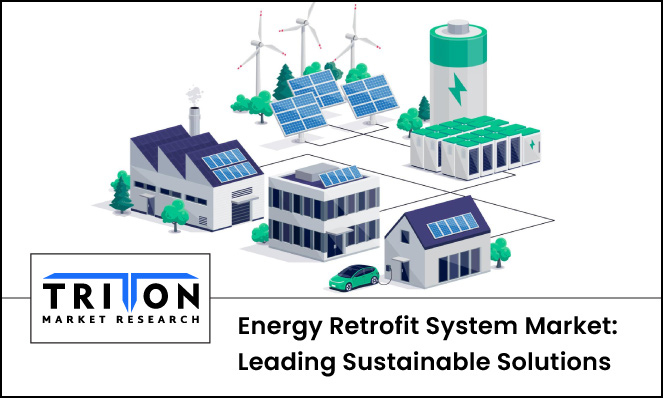



07, March 2024

As energy costs continue to escalate globally, the implementation of energy retrofit systems has surged significantly, marking a transformative shift in how buildings consume energy. As per the International Energy Agency (IEA) report, global energy demand in 2050 is expected to drop by 8% compared to today. Despite this decrease, it will need to support an economy twice its current size and accommodate a population increase of 2 billion people. This urgent need for efficient energy consumption and carbon footprint reduction across sectors, including commercial and residential, is expected to drive the Global Energy Retrofit System Market at a CAGR of 4.05% during 2024-2032.
One of the key pillars for reaching net-zero emissions is the improvement of energy efficiency across all sectors. In this regard, energy retrofit systems provide a comprehensive solution by upgrading existing buildings with advanced technologies to enhance energy efficiency. This further leads to substantial cost savings and environmental benefits.
Explore in detail about this market in our FREE sample
Energy Retrofit Systems Market: Unveiling the Core Products
IEA statistics denote that to be in line with the Net Zero Emissions by 2050 (NZE) Scenario, all nations must implement zero-carbon-ready building energy codes for residential and non-residential structures by 2030. This will require around 20% of existing building floor areas to undergo renovations to meet these standards by the same year.
In this regard, retrofitting envelope components serves to be a critical element in energy efficiency, effectively reducing heating and cooling demands, energy consumption, and, by extension, carbon impact.
Comprising elements like doors, windows, roofs, walls, and insulation, the building envelope plays a crucial role in maintaining a controlled indoor environment while safeguarding against external elements. This symbiotic relationship between building envelopes and energy efficiency fuels the growth of the global energy retrofit system market.
Upgrading HVAC systems stands as a central strategy in energy retrofits, with the potential to substantially lower energy usage and improve indoor air quality. The push for more efficient deployment of HVAC technologies has been vital in the broader adoption of energy retrofit systems.
For instance, Belmino introduced its RetroFIT+ program, which provides online resources like support for easy access to HVAC replacement solutions and product selection tools.
Among the energy retrofit products, LED lighting emerges as a popular choice due to its significant energy savings, long lifespan, and substantial reduction in operational costs. LED retrofits can decrease energy consumption by up to 60%, marking them a critical component of these systems. The rapid adoption of LED lighting, complemented by advancements in smart controls and IoT integration, has prompted various developments by various market contenders.
For instance, in January 2024, Samsung Electronics introduced its latest display lineup ahead of CES® 2024, which includes Neo QLED, MICRO LED, OLED, and Lifestyle displays. While this announcement focuses more broadly on display technology, Samsung's advancements in QLED and OLED technologies indirectly support the ecosystem for LED retrofits via improved efficiency and performance.
Additionally, in May 2023, Fulham Co Inc launched four newly improved LED driver families that include WorkHorse™, ThoroLED™, PONY™, and SugarCube™. These new drivers are designed to meet an urgent need for energy-efficient and eco-friendly lighting solutions.
Europe is at the forefront of the energy retrofit systems industry, owing to rigorous regulatory standards and ambitious sustainability goals. The European Union's Energy Performance of Buildings Directive (EPBD) revision in 2023 supports achieving climate neutrality in the buildings sector by 2050, requiring zero emissions for all new buildings from 2028 and enhancing standards for existing buildings.
As per our estimates, Europe leads in the energy retrofit system market, accounting for around 38% of the global market share.
Besides, the Europe energy retrofit system market is expected to witness the fastest growth over the 2024-2032 forecast years, garnering a CAGR of 4.55%.
Energy retrofit systems promise substantial transformations across residential, commercial, and institutional sectors, enhancing energy efficiency and reducing operational costs. Companies leading these changes, such as Siemens and Johnson Controls, are at the forefront of delivering innovative retrofit solutions that promise cost savings and contribute to environmental conservation.
Connect with our experts for a simplified analysis!
Promising trends, including the integration of smart technologies and a shift towards net-zero buildings, mark the future of energy retrofit systems. These developments underscore the market's potential for significant shifts, offering ample opportunities for research, development, and investment. The adoption of energy retrofit systems represents a response to current challenges and a forward-looking approach to sustainable, efficient energy use.
In retrospect, by emphasizing the critical role of energy efficiency and retrofit systems in achieving net-zero emissions and highlighting Europe's proactive measures in building decarbonization, this analysis highlights the potential of energy retrofit systems in the global push for sustainability.
Explore Our Latest Release for the 2024-2032 Market Analysis
Energy retrofit systems are upgrades to existing buildings that incorporate advanced technologies to improve energy efficiency, resulting in cost savings and environmental benefits.
Q2) Why is there a rising demand for energy retrofit systems?The increasing awareness of environmental sustainability, escalating energy costs, and supportive government policies are driving the demand for energy retrofit systems globally.
Q3) Why is LED lighting a popular choice in energy retrofit systems?LED lighting is favored for its high energy efficiency, longevity, and significant reductions in energy consumption and operational costs.

Prevalent cases of terrorist attacks in today’s world is increasing the need for severe standards of security for public safety, and the global market for biometric technology scrupulously accommoda..
Prevalent cases of terrorist attacks in today’s world is increasing the need for..